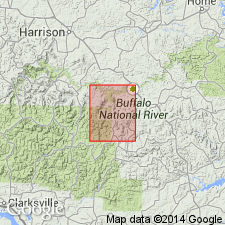
- Usage in publication:
-
- Witts Springs Formation*
- Modifications:
-
- Named
- Reference
- Dominant lithology:
-
- Sandstone
- Shale
- AAPG geologic province:
-
- Arkoma basin
Summary:
Named for the western headwater branch of Calf Creek 2 mi northeast of Witts Springs between secs 1 and 12, T13N, R18W (the type section), Searcy Co, AR in the Arkoma basin. Type section measured. Reference section designated and measured in E1/2 sec 11, T13N, R18W. Is 300 ft thick at type where it unconformably overlies dark gray shale of Cane Hill Formation (rank raised) and unconformably underlies coarse-grained sandstone of the Atoka Formation. At type consists mostly of medium-gray to gray brown, platy to thin-bedded, fine- to medium-grained sandstone with some interbeds of dark gray shale. Individual sandstones may be very thin bedded to massive, and very coarse to fine grained. One thin-bedded, olive-gray siltstone and one very thin-bedded medium gray limestone bed at type. Plant impressions, pelecypods, gastropods, and crinoid casts. Cephalopod fauna (lists) identified. Is 193+ ft thick at reference section, and is of the same general lithology as at type. Is equivalent to Prairie Grove Member of Hale Formation and overlying Bloyd Shale, two units that cannot be mapped in quad and that overlie the Cane Hill and underlie the Atoka in northwest AR. Is of Morrow age.
Source: GNU records (USGS DDS-6; Denver GNULEX).
For more information, please contact Nancy Stamm, Geologic Names Committee Secretary.
Asterisk (*) indicates published by U.S. Geological Survey authors.
"No current usage" (†) implies that a name has been abandoned or has fallen into disuse. Former usage and, if known, replacement name given in parentheses ( ).
Slash (/) indicates name conflicts with nomenclatural guidelines (CSN, 1933; ACSN, 1961, 1970; NACSN, 1983, 2005, 2021). May be explained within brackets ([ ]).

